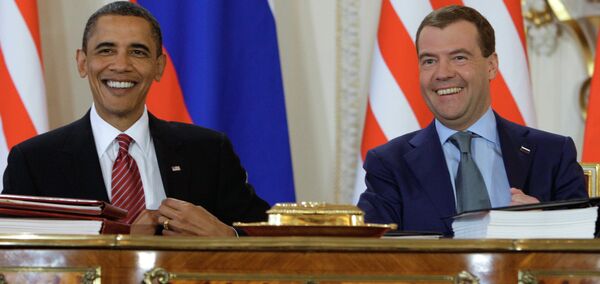Russia and the United States signed on Thursday a new pact on the reduction of strategic offensive weapons to replace the START 1 treaty, which expired in December.
The document, signed by presidents Dmitry Medvedev and Barack Obama, is expected to bring Moscow and Washington to a new level of cooperation in the areas of nuclear disarmament and arms control.
The new strategic arms pact stipulates that the number of nuclear warheads is to be reduced to 1,550 on each side over seven years, while the number of delivery vehicles in operation and in reserve must not exceed 800.
According to a White House press release, "warheads on deployed ICBMs and deployed SLBMs count toward this limit and each deployed heavy bomber equipped for nuclear armaments counts as one warhead toward this limit."
The document, which will be valid for 10 years unless superseded by another agreement, stipulates that each side has the right to unilaterally withdraw from the treaty if it decides that any of the provisions of the treaty could lead to an imminent threat to its national security.
In a nod to Moscow's concerns about the Obama administration's plans to deploy a missile-defense system in Eastern Europe, the preamble of the new treaty states that there is a relationship between offensive and defensive weapons.
However, the treaty itself deals only with limits on offensive weapons systems, and Russia has emphasized its right to withdraw if a quantitative and qualitative increase in U.S. strategic missile defense significantly harmed the effectiveness of Russia's nuclear deterrent.
The new pact addresses the return capability of missile launch facilities and heavy bombers, which would lay the legal groundwork for the subsequent elimination of some types of delivery vehicles.
It contains guarantees that strategic submarines and heavy bombers armed with conventional weapons will not be modified to carry nuclear weapons. Russia has been concerned that the United States could circumvent the arms cuts by returning mothballed delivery vehicles to combat use.
The new pact establishes a simplified verification mechanism, which would almost halve verification costs. Russia has in the past bridled at some of the more intrusive elements of the START 1 treaty, which expired on December 5, 2009.
The verification regime includes on-site inspections, data exchanges and notifications.
The White House said the treaty "does not contain any constraints on testing, development or deployment of current or planned U.S. missile defense programs or current or planned United States long-range conventional strike capabilities."
The new treaty also contains an explicit prohibition on the deployment of strategic offensive weapons in third countries.
Russia and the United States began negotiating the deal after the two countries' presidents met in April last year, but the work on the document dragged on, with U.S. plans for missile defense in Europe a particular sticking point.
After the pact is signed, it has to be ratified by the U.S. Senate and both houses of the Russian parliament to come into effect.
A working group of Russia's Federation Council and the U.S. Senate is due to meet in Washington on April 19-21 to discuss the document's ratification.
PRAGUE, April 8 (RIA Novosti)


